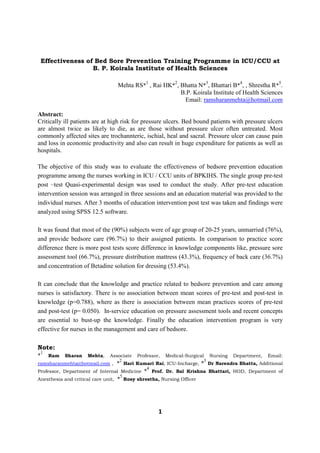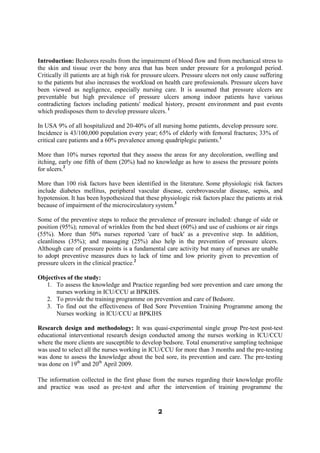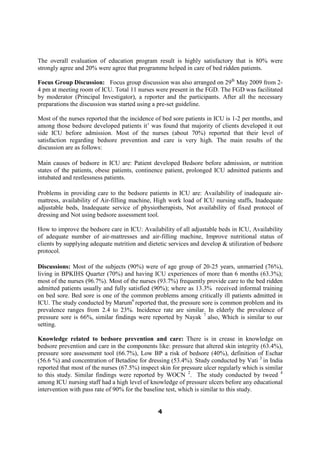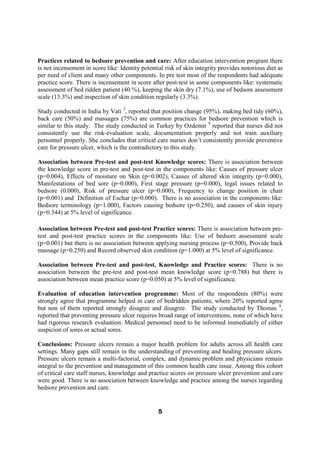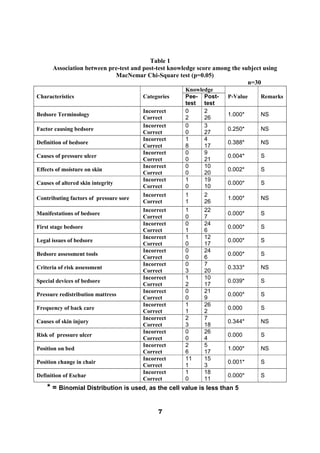9. bed sore education program
- 1. Effectiveness of Bed Sore Prevention Training Programme in ICU/CCU at B. P. Koirala Institute of Health Sciences Mehta RS*1 , Rai HK*2, Bhatta N*3, Bhattari B*4, , Shrestha R*5. B.P. Koirala Institute of Health Sciences Email: ramsharanmehta@hotmail.com Abstract: Critically ill patients are at high risk for pressure ulcers. Bed bound patients with pressure ulcers are almost twice as likely to die, as are those without pressure ulcer often untreated. Most commonly affected sites are trochannteric, ischial, heal and sacral. Pressure ulcer can cause pain and loss in economic productivity and also can result in huge expenditure for patients as well as hospitals. The objective of this study was to evaluate the effectiveness of bedsore prevention education programme among the nurses working in ICU / CCU units of BPKIHS. The single group pre-test post –test Quasi-experimental design was used to conduct the study. After pre-test education intervention session was arranged in three sessions and an education material was provided to the individual nurses. After 3 months of education intervention post test was taken and findings were analyzed using SPSS 12.5 software. It was found that most of the (90%) subjects were of age group of 20-25 years, unmarried (76%), and provide bedsore care (96.7%) to their assigned patients. In comparison to practice score difference there is more post tests score difference in knowledge components like, pressure sore assessment tool (66.7%), pressure distribution mattress (43.3%), frequency of back care (36.7%) and concentration of Betadine solution for dressing (53.4%). It can conclude that the knowledge and practice related to bedsore prevention and care among nurses is satisfactory. There is no association between mean scores of pre-test and post-test in knowledge (p=0.788), where as there is association between mean practices scores of pre-test and post-test (p= 0.050). In-service education on pressure assessment tools and recent concepts are essential to bust-up the knowledge. Finally the education intervention program is very effective for nurses in the management and care of bedsore. Note: 1 * Ram Sharan Mehta, Associate Professor, Medical-Surgical Nursing Department, Email: 2 3 ramsharanmehta@hotmail.com , * Hari Kumari Rai, ICU-Incharge, * Dr Narendra Bhatta, Additional 4 Professor, Department of Internal Medicine * Prof. Dr. Bal Krishna Bhattari, HOD, Department of 5 Anesthesia and critical care unit, * Rosy shrestha, Nursing Officer 1
- 2. Introduction: Bedsores results from the impairment of blood flow and from mechanical stress to the skin and tissue over the bony area that has been under pressure for a prolonged period. Critically ill patients are at high risk for pressure ulcers. Pressure ulcers not only cause suffering to the patients but also increases the workload on health care professionals. Pressure ulcers have been viewed as negligence, especially nursing care. It is assumed that pressure ulcers are preventable but high prevalence of pressure ulcers among indoor patients have various contradicting factors including patients' medical history, present environment and past events which predisposes them to develop pressure ulcers. 1 In USA 9% of all hospitalized and 20-40% of all nursing home patients, develop pressure sore. Incidence is 43/100,000 population every year; 65% of elderly with femoral fractures; 33% of critical care patients and a 60% prevalence among quadriplegic patients.1 More than 10% nurses reported that they assess the areas for any decoloration, swelling and itching, early one fifth of them (20%) had no knowledge as how to assess the pressure points for ulcers.2 More than 100 risk factors have been identified in the literature. Some physiologic risk factors include diabetes mellitus, peripheral vascular disease, cerebrovascular disease, sepsis, and hypotension. It has been hypothesized that these physiologic risk factors place the patients at risk because of impairment of the microcirculatory system.3 Some of the preventive steps to reduce the prevalence of pressure included: change of side or position (95%); removal of wrinkles from the bed sheet (60%) and use of cushions or air rings (55%). More than 50% nurses reported 'care of back' as a preventive step. In addition, cleanliness (35%); and massaging (25%) also help in the prevention of pressure ulcers. Although care of pressure points is a fundamental care activity but many of nurses are unable to adopt preventive measures dues to lack of time and low priority given to prevention of pressure ulcers in the clinical practice.2 Objectives of the study: 1. To assess the knowledge and Practice regarding bed sore prevention and care among the nurses working in ICU/CCU at BPKIHS. 2. To provide the training programme on prevention and care of Bedsore. 3. To find out the effectiveness of Bed Sore Prevention Training Programme among the Nurses working in ICU/CCU at BPKIHS Research design and methodology: It was quasi-experimental single group Pre-test post-test educational interventional research design conducted among the nurses working in ICU/CCU where the more clients are susceptible to develop bedsore. Total enumerative sampling technique was used to select all the nurses working in ICU/CCU for more than 3 months and the pre-testing was done to assess the knowledge about the bed sore, its prevention and care. The pre-testing was done on 19th and 20th April 2009. The information collected in the first phase from the nurses regarding their knowledge profile and practice was used as pre-test and after the intervention of training programme the 2
- 3. information collected was used as post-test. The education intervention programme was carried out during the period of 26th April 2009 to 30th April 2009. The post-test data was collected after 3 months of education intervention programme i.e. on 30th and 31st July 2009. The difference in knowledge and practice was determining the effectiveness of the training intervention. Three days teaching learning session was arranged for all the nurses. The education intervention package prepared is provided individual nurses. The theoretical as well as practical knowledge was imparted on them. The subjects were fully oriented about the purpose of study and their consent was obtained prior to data collection. The validity of the tool and the package was established with the concerned experts from the nurses, doctors and researchers. Results: Most of the subjects (90%) were of age group of 20-25 years, unmarried (76%), stay in BPKIHS Quarter (70%), mean ICU experiences of 13.2 months, and mean nursing service experience in BPKIHS was 16.53 months. Most of the subjects (96.7%) provide bed sore prevention and care activities to their assigned patients and most of them (90%) were satisfied with service provided to assigned patients; where as only 13.3% nurses had only received bed sore training program. In some of the areas like: common terminology, common sites of bedsore occurrence, high risk patients & skin as first degree defense line. The pretest and post-test score is same. The maximum difference in knowledge after post test was found in, pressure that altered skin integrity (63.4 %), pressure sere assessment tool (66.7 %), pressure reduction mattress (43.3 %), low BP. As risk of bed sore (40 %), concentration of Betadine for dressing (53.4 %) and massage the skin where it is tight over bones (59.9 %). There are not many differences in score of practices after education interventions in most of the components. The areas where raises in scores in practices are, applying nursing process while providing bedsore care (10%), use of assessment scale (13.3%), systematic assessment of bed ridden patient (40%), and always keep the skin dry (7%). There is association between the knowledge score in pre-test and post-test in the components like: Causes of pressure ulcer (p=0.004), Effects of moisture on Skin (p=0.002), Causes of altered skin integrity (p=0.000), Manifestations of bed sore (p=0.000), First stage pressure (p=0.000), legal issues related to bedsore (0.000), Risk of pressure ulcer (p=0.000), Frequency to change position in chair (p=0.001) and Definition of Eschar (p=0.000). There is no association in the components like: Bedsore terminology (p=1.000), Factors causing bedsore (p=0.250), and causes of skin injury (p=0.344) at 5% level of significance .The details are mention in table – 1. There is association between pre-test and post-test practice scores in the components like: Use of bedsore assessment scale (p=0.001) but there is no association between applying nursing process (p=0.500), Provide back massage (p=0.250) and Record observed skin condition (p=1.000) at 5% level of significance. The details are depicted in table – 2. There is no association between the pre-test and post-test mean knowledge score (p=0.788) but there is association between mean practice score (p=0.050) at 5% level of significance. The details are depicted in table – 3. 3
- 4. The overall evaluation of education program result is highly satisfactory that is 80% were strongly agree and 20% were agree that programme helped in care of bed ridden patients. Focus Group Discussion: Focus group discussion was also arranged on 29th May 2009 from 2- 4 pm at meeting room of ICU. Total 11 nurses were present in the FGD. The FGD was facilitated by moderator (Principal Investigator), a reporter and the participants. After all the necessary preparations the discussion was started using a pre-set guideline. Most of the nurses reported that the incidence of bed sore patients in ICU is 1-2 per months, and among those bedsore developed patients it’ was found that majority of clients developed it out side ICU before admission. Most of the nurses (about 70%) reported that their level of satisfaction regarding bedsore prevention and care is very high. The main results of the discussion are as follows: Main causes of bedsore in ICU are: Patient developed Bedsore before admission, or nutrition states of the patients, obese patients, continence patient, prolonged ICU admitted patients and intubated and restlessness patients. Problems in providing care to the bedsore patients in ICU are: Availability of inadequate air- mattress, availability of Air-filling machine, High work load of ICU nursing staffs, Inadequate adjustable beds, Inadequate service of physiotherapists, Not availability of fixed protocol of dressing and Not using bedsore assessment tool. How to improve the bedsore care in ICU: Availability of all adjustable beds in ICU, Availability of adequate number of air-mattresses and air-filling machine, Improve nutritional status of clients by supplying adequate nutrition and dietetic services and develop & utilization of bedsore protocol. Discussions: Most of the subjects (90%) were of age group of 20-25 years, unmarried (76%), living in BPKIHS Quarter (70%) and having ICU experiences of more than 6 months (63.3%); most of the nurses (96.7%). Most of the nurses (93.7%) frequently provide care to the bed ridden admitted patients usually and fully satisfied (90%); where as 13.3% received informal training on bed sore. Bed sore is one of the common problems among critically ill patients admitted in ICU. The study conducted by Marum6 reported that, the pressure sore is common problem and its prevalence ranges from 2.4 to 23%. Incidence rate are similar. In elderly the prevalence of pressure sore is 66%, similar findings were reported by Nayak 7 also, Which is similar to our setting. Knowledge related to bedsore prevention and care: There is in crease in knowledge on bedsore prevention and care in the components like: pressure that altered skin integrity (63.4%), pressure sore assessment tool (66.7%), Low BP a risk of bedsore (40%), definition of Eschar (56.6 %) and concentration of Betadine for dressing (53.4%). Study conducted by Vati 3 in India reported that most of the nurses (67.5%) inspect skin for pressure ulcer regularly which is similar to this study. Similar findings were reported by WOCN 2. The study conducted by tweed 4 among ICU nursing staff had a high level of knowledge of pressure ulcers before any educational intervention with pass rate of 90% for the baseline test, which is similar to this study. 4
- 5. Practices related to bedsore prevention and care: After education intervention program there is not incensement in score like: Identity potential risk of skin integrity provides notorious diet as per need of client and many other components. In pre test most of the respondents had adequate practice score. There is incensement in score after post-test in some components like: systematic assessment of bed ridden patient (40 %), keeping the skin dry (7.1%), use of bedsore assessment scale (13.3%) and inspection of skin condition regularly (3.3%). Study conducted in India by Vati 3, reported that position change (95%), making bed tidy (60%), back care (50%) and massages (75%) are common practices for bedsore prevention which is similar to this study. The study conducted in Turkey by Ozdemir 9 reported that nurses did not consistently use the risk-evaluation scale, documentation properly and not train auxiliary personnel properly. She concludes that critical care nurses don’t consistently provide preventive care for pressure ulcer, which is the contradictory to this study. Association between Pre-test and post-test Knowledge scores: There is association between the knowledge score in pre-test and post-test in the components like: Causes of pressure ulcer (p=0.004), Effects of moisture on Skin (p=0.002), Causes of altered skin integrity (p=0.000), Manifestations of bed sore (p=0.000), First stage pressure (p=0.000), legal issues related to bedsore (0.000), Risk of pressure ulcer (p=0.000), Frequency to change position in chair (p=0.001) and Definition of Eschar (p=0.000). There is no association in the components like: Bedsore terminology (p=1.000), Factors causing bedsore (p=0.250), and causes of skin injury (p=0.344) at 5% level of significance. Association between Pre-test and post-test Practice scores: There is association between pre- test and post-test practice scores in the components like: Use of bedsore assessment scale (p=0.001) but there is no association between applying nursing process (p=0.500), Provide back massage (p=0.250) and Record observed skin condition (p=1.000) at 5% level of significance. Association between Pre-test and post-test, Knowledge and Practice scores: There is no association between the pre-test and post-test mean knowledge score (p=0.788) but there is association between mean practice score (p=0.050) at 5% level of significance. Evaluation of education intervention programme: Most of the respondents (80%) were strongly agree that programme helped in care of bedridden patients; where 20% reported agree but non of them reported strongly disagree and disagree. The study conducted by Thomas 8, reported that preventing pressure ulcer requires broad range of interventions, none of which have had rigorous research evaluation. Medical personnel need to be informed immediately of either suspicion of sores or actual sores. Conclusions: Pressure ulcers remain a major health problem for adults across all health care settings. Many gaps still remain in the understanding of preventing and healing pressure ulcers. Pressure ulcers remain a multi-factorial, complex, and dynamic problem and physicians remain integral to the prevention and management of this common health care issue. Among this cohort of critical care staff nurses, knowledge and practice scores on pressure ulcer prevention and care were good. There is no association between knowledge and practice among the nurses regarding bedsore prevention and care. 5
- 6. References: 1. Guideline for prevention and management of pressure ulcers. Wound, Ostomy, and Continence Nurses Society; 2003:52. 2. Vati J, chopra S, Walia I. Nurses Role in the management and prevention of pressure ulcer. Nursing Journal of India. May 2004. 3. Clough NP. The cost of pressure area management in an intensive care unit. J Wound Care. 1994; 3:33–35. 4. Tweed C, Tweed M. Intensive care nurses knowledge of pressure ulcer: Development of an assessement tool and effect of and educational programme. Am. J. Crit. Care. 2008: 17: 338-346. 5. Bostrom J, Kenneth H. Staff Nurses knowledge and prevention about prevention of pressure sores. Dermatol Nurss 1992; 4(5):365-8. 6. Marum RV, Ooms ME, Ribble MW, Eijk JT. The Duch pressure sore assement score or the Norten Scale for identifying at-risk nursing home patients?. Age and Ageing. 2000; 29: 63-68. 7. Nayak D, Srinivasan K, Jagdish S, Rattan R, Chatram VS. Bedsores: top to bottom and bottom to top. Indian J. Surg..2008; 70: 161-168. 8. Thomas DR, Goode PS, Tarquine PH, Allman RM. Hospital-acquired ulcers and risk of death. J Am Geriatr Sco. 1996; 7:48-56. 9. Ozdemir H, Karadag A. Prevention of pressure ulcers: a descriptive study in three intensive care units in Turkey. J. wound Ostomy Continence Nurs. 2008; 35(3): 293-300. 6
- 7. Table 1 Association between pre-test and post-test knowledge score among the subject using MacNemar Chi-Square test (p=0.05) n=30 Knowledge Characteristics Categories Pee- Post- P-Value Remarks test test Incorrect 0 2 Bedsore Terminology 1.000* NS Correct 2 26 Incorrect 0 3 Factor causing bedsore 0.250* NS Correct 0 27 Incorrect 1 4 Definition of bedsore 0.388* NS Correct 8 17 Incorrect 0 9 Causes of pressure ulcer 0.004* S Correct 0 21 Incorrect 0 10 Effects of moisture on skin 0.002* S Correct 0 20 Incorrect 1 19 Causes of altered skin integrity 0.000* S Correct 0 10 Incorrect 1 2 Contributing factors of pressure sore 1.000* NS Correct 1 26 Incorrect 1 22 Manifestations of bedsore 0.000* S Correct 0 7 Incorrect 0 24 First stage bedsore 0.000* S Correct 1 6 Incorrect 1 12 Legal issues of bedsore 0.000* S Correct 0 17 Incorrect 0 24 Bedsore assessment tools 0.000* S Correct 0 6 Incorrect 0 7 Criteria of risk assessment 0.333* NS Correct 3 20 Incorrect 1 10 Special devices of bedsore 0.039* S Correct 2 17 Incorrect 0 21 Pressure redistribution mattress 0.000* S Correct 0 9 Incorrect 1 26 Frequency of back care 0.000 S Correct 1 2 Incorrect 2 7 Causes of skin injury 0.344* NS Correct 3 18 Incorrect 0 26 Risk of pressure ulcer 0.000 S Correct 0 4 Incorrect 2 5 Position on bed 1.000* NS Correct 6 17 Incorrect 11 15 Position change in chair 0.001* S Correct 1 3 Incorrect 1 18 Definition of Eschar 0.000* S Correct 0 11 * = Binomial Distribution is used, as the cell value is less than 5 7
- 8. Table 2 Association between pre-test and post-test Practice score among the subject using MacNemar Chi-Square test (p=0.05) n=30 Practices Characteristics Categories Pre- Post- P-Value Remarks test test No 0 2 Apply Nursing Process Yes 0 28 0.500* NS No 8 14 Use of Assessment Scale 0.001* S Yes 1 7 No 0 2 Maintain Turning Schedule 1.000* NS Yes 1 27 No 0 1 Provide Nutritious Diet 1.000* NS Yes 2 27 No 0 0 Provide Back Massage 0.250* NS Yes 3 27 No 3 4 Record Observed Skin condition 1.000* NS Yes 3 21 * = Binomial Distribution is used, as the cell value is less than 5 Table 3 Association between pre-test and post-test Knowledge and Practice Mean score among the subject using Pearson Chi-Square test (p=0.05) N=30 Pre-test Post-test Characteristics/ SD/ SD/ P-value Remark Variables Mean Mean Value Range Value Range 2.931/ 2.426/ Knowledge 18.4 25.8 0.788 NS 12-25 21-31 1.87819/ 1.779/ Practice 22.7 23.6 0.050 S 18-25 18-26 8
